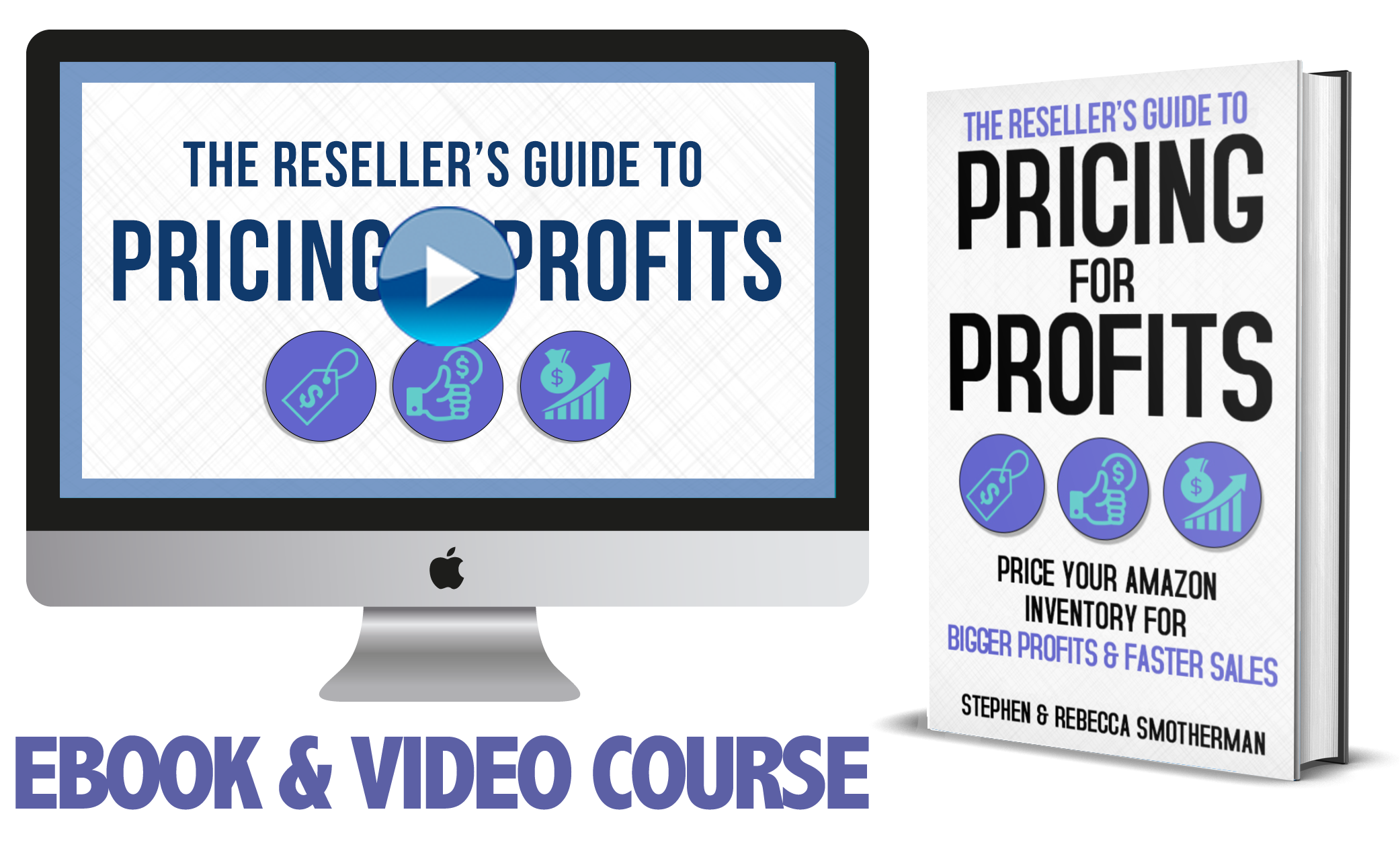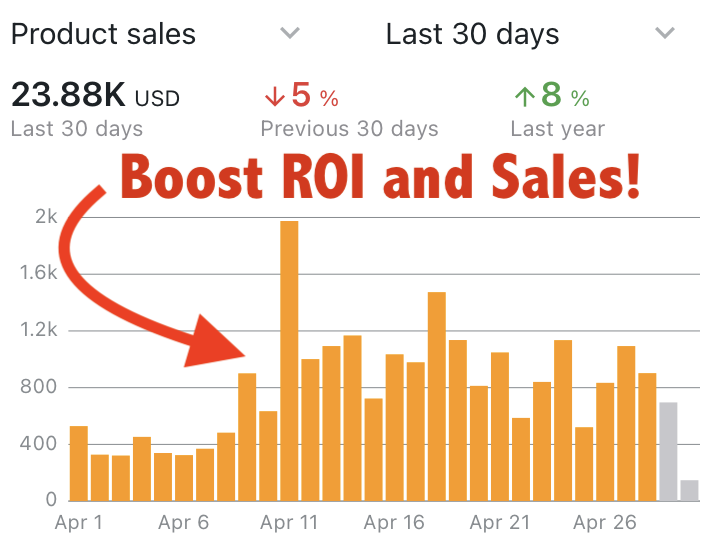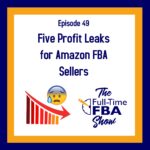It doesn’t matter how big your Amazon boat is, if it’s got a leak, then it’s going to sink. In today’s episode, we tackle five major profit leaks that affect many Amazon FBA sellers, also giving you solutions that will increase your revenue stream.
We’ll break down all of the hidden and forgotten fees that are stealing your profits and show you how to lower these fees with just a few tweaks to your Amazon FBA business.
One of the biggest profit leaks is because of some pricing mistakes that are stopping you from making more profits on your inventory. We’ll show you how you can quickly react to price drops before your competitors do, letting you gain some profit before prices become painfully low. You’re working too hard to make less money than you could, so this entire episode is focused on safeguarding your profits.
Listen on the podcast player below.
Like what you hear? Tell a friend… and be sure to leave us a rating and a review. Here’s how.
Key points from Episode 49:

- How you can lower the main fees that are often forgotten.
- Kill your darlings; knowing when to lower your price to offload products.
- Using Amazon’s Inventory Dashboard to project your storage fees.
- Plugging your profit leaks by using Keepa, an Amazon price checker.
- Thinking like a CEO and not an employee, and outsourcing your work.
- Identifying your past winners and trying to sell them again.
- Reacting to product and competitor price drops to land sales.
- How to make sure you don’t run out of stock for a high-selling item.
- And more!
Links and resources mentioned in this episode:
 Keepa
Keepa- How to Read & Understand Keepa Graphs
- Podcast Episode #10 – Ten Things to Outsource in Your Amazon FBA Business
- Evernote
- BQool
- Full-Time FBA BQool Review
- InventoryLab Review
- Inventory Lab 30-Day Free Trial
Right-click here and save as to download this episode to your computer.
 More Episodes from the Full-Time FBA Show podcast:
More Episodes from the Full-Time FBA Show podcast:
Don’t miss an upcoming episode! Subscribe, download episodes, and review the Full-Time FBA Show:
-
-
- Subscribe on iTunes
- Follow on Spotify
- Follow on Amazon Music (or just ask Alexa to “play The Full-Time FBA Show podcast”)
- Follow on iHeartRadio
- Subscribe on Podbean
- Subscribe on Podbay
- Subscribe on Podchaser
-
![]()
 The Reseller’s Guide to Pricing for Profits
The Reseller’s Guide to Pricing for Profits
Do you have a strategic pricing strategy for the items you’re selling on Amazon? Your pricing game plan can determine whether your Amazon FBA business succeeds or fails.
Amazon (as a seller) has a pricing strategy… and successful third-party sellers have a pricing strategy. It’s about time you had a tactical and calculated pricing strategy that will help take your Amazon business to the next level.
 In The Reseller’s Guide to Pricing for Profits, we’ll help you craft and execute the perfect pricing strategy that will help you increase your profits while still consistently selling your inventory. With this course you’ll be able squeeze more ROI out of every single items in your inventory. With increased profits you’ll be able to grow your Amazon business faster and set yourself up for long-term success.
In The Reseller’s Guide to Pricing for Profits, we’ll help you craft and execute the perfect pricing strategy that will help you increase your profits while still consistently selling your inventory. With this course you’ll be able squeeze more ROI out of every single items in your inventory. With increased profits you’ll be able to grow your Amazon business faster and set yourself up for long-term success.
The course is a combination video course (3+ hours of training) and a 70+ page ebook. The videos and book both share the exact same content (so you can pick the format you most like to learn from). The course also comes with multiple bonuses no additional charge!
As a special podcast perk, use the coupon code PROFIT and that will take $10 off the cost! Just know that the coupon code will expire very soon. Use the coupon code and enroll in The Reseller’s Guide to Pricing for Profits today.
![]()
Back to the main page for The Full-Time FBA Show
![]()
Episode 49 Transcript:
 [INTRODUCTION]
[INTRODUCTION]
[0:00:01.8] ANNOUNCER: Welcome to The Full-Time FBA Show. In each episode, it’s our goal to help you turn part time hours into a full-time income, selling almost anything on Amazon. Now, your hosts of the show, Stephen and Rebecca Smotherman.
[INTERVIEW]
[0:00:21.4] REBECCA: Hello everyone and welcome to this episode of the full-time FBA show, we’re so glad you’re here with us. And we are going to be talking today about five profit leaks for your Amazon FBA business that you want to make sure you take care of — so that you don’t continue to leak out profits. And with me today is my co-host, as always, Stephen. Hello Stephen.
[0:00:44.1] STEPHEN: How’s it going Rebecca?
[0:00:45.2] REBECCA: It is going great.
[0:00:46.6] STEPHEN: Good, yeah, I’m looking forward to talking about this because you know, if you’re in a boat and there’s a leak, then you’re going to go down. And we want to make sure your Amazon business does not go down so we will try to plug these leaks up for you today and help you retain your profitability.
[0:01:01.6] REBECCA: Sounds good. I’m going to try really hard to say leak throughout this episode and not link because I keep saying that accidentally.
[0:01:07.9] STEPHEN: Yes.
[0:01:08.7] REBECCA: I don’t think I’ve said it so far but if I do, I’m apologizing ahead of time.
[0:01:12.9] STEPHEN: Yeah, because we will be sharing links later — as also, you know.
[0:01:16.0] REBECCA: That’s confusing. All right, we have five Amazon FBA profit leaks that we’re going to be talking about today. But there are actually more leaks that Stephen identified as he was doing his research for this podcast episode. Be on the lookout, we might have that coming up for you in a future episode. There might be more but these are the ones that we’re going to focus on for now.
All right, tell us the first one that you think is a profit leak that Amazon FBA sellers need to be on the watch out for so that they can take care of it and the boat won’t sink.
[0:01:54.8] STEPHEN: Yeah, a lot of times when people are sourcing for inventory to sell on Amazon, you know, they’re looking at Amazon FBA fees. And what they’re going to take out for each sale. But one of the biggest fees that a lot of people ignore are the storage fees. Everyone assumes that — especially when they’re starting, that when they buy items to sell on Amazon, they’re going to sell quickly. Storage fees aren’t going to be that big of a deal.
But if you’ve been selling on Amazon for any amount of time, you start to realize, there’s some stuff that might take months to sell. And maybe even, potentially, like a full year to sell. Those storage fees can really add up over time and there’s different storage fees to be aware of, there are monthly storage fees, there are Q4 storage fees, meaning, the last three months of the year, the storage fees for standard sized items are quadruple from the rest of the year. And then there’s long-term storage fees that are even bigger for items that have been in an Amazon warehouse over a year.
Even though you might have purchased an item thinking, “I’m going to make 10 bucks off of this item when it sells.” Well, there’s some items that — it could take a few months of storage fees or a few months of Q4 storage fees and definitely, long-term storage fees that can totally wipe out your profits. So you’re not actually making money, your profits are leaking out because you’re paying these storage fees.
It’s important to know that when you are buying your inventory and you’re trying to sell it, I’ve heard this phrase before, don’t be married to your inventory. There’s sometimes you just need to let it go, you need to lower the price to be able to sell the item, to get that capital back so you can reinvest it in better selling inventory.
I think in the writer’s world, Stephen King calls it killing your darlings, is that right?
[0:03:36.9] REBECCA: Yes, yeah.
[0:03:39.0] STEPHEN: There might be some inventory items that you just need to say goodbye to and realize you’re not going to get the sale at the price you expected. That is something that could really eat into your profits.
[0:03:49.9] REBECCA: Yeah, I think about, with that, Amazon makes it pretty easy to quantify what the potential damage could be. If you go to your inventory dashboard and you look at the inventory planning there, it will tell you — “Last month, this is how much you paid in storage fees.”
And then if you look at that, I think it’s your excess inventory page, it will tell you for each of the items that Amazon’s algorithm considers to be excess inventory, whether you agree with it or not. The algorithm is saying that that is excess inventory. It will tell you, here’s the projected storage fees for this item over what is it, a year?
[0:04:25.1] STEPHEN: Yeah.
[0:04:24.7] REBECCA: Does it say that? Some of them are crazy high and so I think that’s part of why they’re saying this is excess. If it’s not selling fast enough and it’s got a high fee for whatever reason, you know, based on the size and whatnot and the rate that it’s selling at. That, to me, has been kind of an eye opener to be like, “Yeah, I need to do something here because those storage fees are going to take away any profit that I might have once thought I was going to get.”
[0:04:50.0] STEPHEN: Yeah, and there’s two potential ways that you could plug this profit leak. One of them is by using Keepa when you are sourcing your inventory. Keepa, I talk about it a lot, it tracks your pricing history and sales rank history of almost every item on Amazon. And so, just because an item is priced at $50 today doesn’t mean it will sell at $50 on a regular basis.
You can look at the Keepa graph and look into the past to better to predict the future of the sales and so you can actually source smarter when you use that Keepa information, you can get more information about Keepa fulltimefba.com/keepa if you want a quick training video on how to use and understand it fulltimefba.com/readkeepa.
That’s one way you can plug that leak, a second way you can plug that profit leak is to use an automatic repricer. A lot of times, the reason why you are paying monthly storage fees is because the price has gone down a little bit and you have not reacted to that price going down a little bit. And so you’re not going to get the sale because, you know what? Selling for two or three dollars, less than what you first priced to that. Using an automatic repricer might help you make better choices, might help you avoid those profit leaks by selling the items sooner just by maybe lowering the price a little bit automatically.
[0:06:03.6] REBECCA: All right, those are good solutions there. Let’s move on to the next one, what is the second profit leak that you’ve identified that we should be aware of?
[0:06:13.8] STEPHEN: This one might not be as quantifiable as the monthly storage fees, we can actually look into our fees and our reports on Amazon to see exactly what we’re paying with the monthly storage fees and other types of storage fees. But with this profit leak, it’s a big one and the leak is that you are not outsourcing. Think about your Amazon business. If you are really wanting it to be a business, you need to have the mindset of a CEO. Which would you rather be? Would you rather be the boss or would you rather be the employee?
If you are trying to do everything yourself, then your profits are leaking because you really should be spending your time on the most important part that — what you have the most skills on. And if you don’t have the skills in learning those skills that will help bring you the most bang for your buck. If you think about the amount of time that you spend and the money that you are bringing home because of the time that you spend. Well, you can actually do a calculation and figure out how much money you’re making per hour.
Find out and see for yourself the things that you are doing in your Amazon business — which activities bring you the most profit? I mean, do you think a CEO would be taking price stickers off of an item? Or poly-bagging an item or packing up boxes? That’s not something that the CEO would be doing. And so you want to look at your Amazon business the same way, find ways to outsource it. If you can find someone to be paid a minimum wage, fair, to do something that you are doing right now then you’re not using your time and money wisely.
Outsource it and that’s how you plug this, you find out what you need to outsource, what are the things that you’re doing that you should not be doing that anyone can do. And then find someone else to do that. We have a whole podcast episode on outsourcing, fulltimefba.com/10. Our 10th episode was all about outsourcing and how we can help you, but yes, if you try to do everything, your profits are leaking because you’re just spending way too much time on things that pretty much anybody can do. Instead of spending your time on the things that only you should be doing.
[0:08:22.6] REBECCA: Yeah, that’s been a huge one for us. We have that whole episode about it but we bring it up pretty regularly. And so if you’ve listened for any amount of time to the podcast, you know how much we love outsourcing and how much we value the time that we get back every time we find a new task that we can outsource. We are always asking ourselves what else can we outsource, what else can somebody else be doing for us?
All right, the third profit leak that we’re going to talk about today, I don’t know, this one might be my favorite one to do, I love it when I am able to do this one and make some extra profits because I am not losing out on this. Tell us what the third one is on our list Stephen?
[0:09:01.0] STEPHEN: The third profit leak is not re-checking old winners. Now, this is what I mean by that. A lot of times when people source for their Amazon FBA business, try to find inventory. Once an item is sold, it’s kind of out of mind, I mean, it’s out of sight, out of mind. But there are opportunities still around you that are profitable items for you to restock. So a really great thing for you to do, and this is how you can plug that leak. You can go on into your seller central account, you hover over reports and look at your business reports. Then you can look at all of your inventory, the sales and traffic by ASIN and then you can sort that by units descending, in a descending order.
It will tell you over the last month, which items you’ve sold the most of. You know, you might have gone to a store one time and cleared the shelf of an item and you sold through all those items. Well, it’s possible if you go back, you might be able to still find more of those items. Now, if you purchased it with clearance prices, maybe not. But if you purchased it at a regular price or if you purchased it with an online arbitrage list, it still could be profitable. And I have done that before. I’ve gone through an old OA lead list that I have purchased before in the past and found out there’s — some of those items that are still profitable. So then it used to be a winner before I sold out of them.
I was able to go back and find more to restock. I find, also, a lot of people asking me, “Well, how can I learn how to find replenishables?” Well, one of the best ways that you can find a replenishable, which is not if you continue order over and over again, is to look through your past winners and see if you can go find those past winners to sell again.
[0:10:40.3] REBECCA: Yeah and this is great too for — you know, in some instances, it might not just be that, “Oh I sold out and then I never replenished it” it might be that a bunch of other people came in on the listing and so I stopped selling it. You know I’ve sold out of what stock I had and then stopped selling it because it was no longer profitable. Well, three to four to five minutes later is everybody else still selling it? You need to check up on that and see.
Maybe everybody else sold out of it and isn’t jumping back in on that listing and you still have your source and you can get back in on it and make really good money on it again.
[0:11:12.3] STEPHEN: Yeah and that is another cool tool that Keepa gives you. You can actually see that price alerts, maybe a price has tanked and it is no longer profitable for you so you stop selling it. Well, you can go into Keepa on that particular item and set up a price alert. So when the price recovers, when it goes back up, when it hits that price and you’re like, “Oh my gosh it is back to the higher price that was selling before. I can now make it profitable by going and finding that item again.”
So it’s really good. And one more thing with this tip, Q4 is coming up. For those of you who are listening right after this episode dropped, it is a really good time to go back and look at last year’s biggest winners for doing Q4. Some stuff you might think, “Oh, I remember what was selling really well,” you won’t remember at all. Go back and look at last year’s Q4 success, those statistics, which items you sold the most during Q4 of last year to refresh your mind and be able to go out and find those items again.
[0:12:05.1] REBECCA: Yeah and you can do all of these by looking at different Amazon reports in seller central — and also, this is why we are always telling people to take notes. Keep a notebook, keep a spreadsheet, use the Evernote app, whatever you have to do keep really good notes. I try to keep spreadsheets of everything because it is easy to run through a scanning program again or whatever. But keep really good notes. Make notes of ASINs and prices and sources and all of that because that makes this aspect of it so much easier.
[0:12:33.4] STEPHEN: Yep.
[0:12:34.4] REBECCA: All right, so moving along. We’ve had storage fees, we’ve had not outsourcing, we’ve had not rechecking those old winners in your inventory. What is the fourth leak of profits that you think Amazon FBA sellers should be on the lookout for?
[0:12:52.4] STEPHEN: So one of the worst things for Amazon FBA sellers is when you buy an item and the price tanks. That is always frustrating but you could have made a small change when you first priced that item that could have helped avoid this. You know the competition comes in, maybe there is a big clearance sale and so everyone in the world is sending these items into Amazon. The supply goes up and the prices go down and your profits go down.
Well one of the ways that you can avoid the tanking prices situation is to make sure that you have a repricer set up to make sure that your price stays competitive. Maybe you priced the item at $30. And you send it to Amazon. A lot of people just price it, set it and forget it, don’t go back and check anything but if you set up a minimum and a maximum price with your repricer for that particular item, maybe your price could automatically be updated to be tweaked a few dollars down. And you can still be able to make a profit on it.
Not as much as you first thought but you’re still at least making a profit before the price tanks even lower and you have to lose even more money on that sale. So having your prices priced competitively is a big deal. We use the repricer called BQool. You can read my review about it, fulltimefba.com/bqoolreview that’s BQool and again, we’ll have all of these links. We have shared a lot of links, we’ll put those in the show notes.
But that will help you with not having those prices tank to where it is not profitable anymore for you. You can tweak your price just a little bit and still make a really good profit and not have that profit leaking out because everyone else is tanking their prices.
[0:14:35.1] REBECCA: All right, that brings us to our last one. What is number five on our list here?
[0:14:40.4] STEPHEN: Number five and again, to say what Rebecca was talking about earlier — we have more profit leaks that we want to talk to you about again in the future. So be looking for that in a future podcast episode. But number five for today is not restocking fast enough. And we talked about replenishables a minute ago. It is really good to find your replenishables but what happens if you don’t replenish fast enough?
You sell out and you have zero in stock. That is something where you are losing out on those profits because you’ve let your inventory items sell out. It’s called stock-out — it’s the fancy term. And so you just want to make sure that you avoid that and we use a tool called InventoryLab. InventoryLab has a velocity report where it sees what the inventory velocity currently is. And you can type in your lead time on how long it takes for you to go get that inventory and send it to Amazon or order it from a supplier and send it to Amazon.
You can put in your safety stock number, which is like, when the stocks gets down to the list level, you need to alert me that I need to reorder it. And so that is what InventoryLab does. They will let you know how to reorder or that you need to reorder and then you can go and make sure that you don’t ever sell out of a particular item. And it is a really valuable tool and one that I fail to use sometimes. There are all of these tools out there and things that you need to do. And I admit that there is something that I sometimes let go and one to make sure that I recommit myself to. But check out the InventoryLab velocity report. InventoryLab is a great tool, fulltimefba.com/inventorylab for a 30-day free trial. But you know what? If you don’t have that inventory in stock, obviously that is leaking your profits and that boat is going to sink.
[0:16:20.5] REBECCA: Yep, you can’t sell it if it is not in stock.
[0:16:23.1] STEPHEN: Yes.
[0:16:23.6] REBECCA: All right, so our five profit leaks that we talked about: Storage fees, number one. Number two, not outsourcing. Number three, not rechecking your old winners. Number four, our least favorite, tanking prices and number five, not restocking fast enough. So as Stephen has said, we have covered a lot of links and leaks. But I was going to say link on purpose that time. So we have covered a lot of links in this episode and you’ll want to be sure to check out the show notes for this page because we’ll have all of these organized there for you.
You can find those shownotes at fulltimefba.com/49, this is episode number 49. We are getting close to a nice round 50 there. That is pretty exciting.
[0:17:09.8] STEPHEN: Sweet.
[0:17:10.3] REBECCA: All right, so be sure and check that out and leave us a comment there too if you can think of another leak of profits that you have identified and are working on in your own business.
[0:17:20.8] STEPHEN: Yeah, we’d love to hear from you.
[END OF DISCUSSION]
[0:17:24.9] REBECCA: All right, before we go, we wanted to share with you a couple of five-star reviews of the podcast and we love getting these reviews and hearing from you. So the first one we wanted to share says, “Great info. Stephen and Rebecca are a wealth of information. I love their down-to-Earth approach. They obviously love what they do.” And we appreciate that feedback. We do love what we do and we hope that we are able to provide a lot of information that you can really benefit from. So thank you for letting us know that.
The second one says, “This is my new favorite show. I can’t get enough.” And we are glad that you feel that way and we love bringing you a new episode every Monday. And we are so grateful for all of the reviews that we get. And thank you for listening and we thank you for letting us know how you feel about the show. We are just grateful that we can do this for the FBA community and that all of you out there are so supportive.
[0:18:25.0] STEPHEN: Yeah, so if you want to leave us a review, go find your favorite podcast app and leave us a review at The Full-Time FBA Show. All right, next week on the show, we’re going to be talking about how to prepare for Q4. Q4 being the last three months of the year — is almost always the most profitable time for Amazon sellers. So we are going to talk about what you can do to maximize your profits and how to best prepare for all the awesome things Q4 has to offer.
We’ll even throw in a few predictions on what we think Q4 will be like this year. So be sure to come back and join us next week on The Full-Time FBA Show.
[OUTRO]
[0:19:01.0] ANNOUNCER: That is all for this episode of The Full-Time FBA Show. So head over to fulltimefba.com/podcast, where you will find the show notes and links from this episode. While you’re there, subscribe to our newsletter where you’ll get several free downloads of our popular and helpful Amazon FBA resources. Now, take action on what you have learned today so you can find success at turning part-time hours into a full-time income with Amazon FBA.
[END]

Leave a Reply